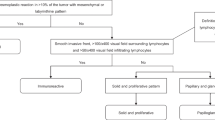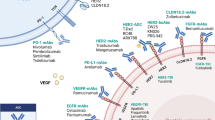Abstract
Purpose
This study was conducted to determine the clinical significance of serum M30 and M65 in epithelial ovarian cancer (EOC).
Methods
A total of 56 patients with EOC and 56 healthy women were included in the study. All of the patients received platinum-based chemotherapy. Pretreatment levels of M30 and M65 were measured using the quantitative ELISA method.
Results
The median M30 and M65 serum levels were significantly elevated in the EOC patients compared with the healthy controls (96.7 vs. 69.5, p = 0.028 and 436.4 versus 166.3, p < 0.001, respectively). The cut-off value of 423.4 U/L for M65 determined with ROC analysis, predicted progression with 75.1 % sensitivity and 65.6 % specificity (AUC = 0.708, p = 0.008). Patients with higher M65 levels had shorter progression-free survival (PFS) (p = 0.021). Both M30 and M65 serum levels were significantly higher for serous-type histology (p = 0.001 and p < 0.001, respectively). Increased M65 serum levels were associated with advanced disease (p = 0.005) and higher grade (p = 0.005). Moreover, M65 levels were higher for chemotherapy-resistant patients (p = 0.04). Multivariate analysis revealed that an elevated serum M65 level was the only significant independent prognostic factor (p = 0.039, HR 3.792).
Conclusions
These results indicated that serum M30 and M65 levels were significantly elevated in patients with EOC compared with healthy women. Particularly, high serum M65 levels were associated with poor prognosis and resistance to platinum-based chemotherapy.


Similar content being viewed by others
References
Siegel R, Naishadham D, Jemal A (2012) Cancer statistics, 2012. CA Cancer J Clin 62(1):10–29. doi:10.3322/caac.20138
Cannistra SA (2004) Cancer of the ovary. N Engl J Med 351(24):2519–2529. doi:10.1056/NEJMra041842
Jemal A, Bray F, Center MM, Ferlay J, Ward E, Forman D (2011) Global cancer statistics. CA Cancer J Clin 61(2):69–90. doi:10.3322/caac.20107
Gadducci A, Cosio S, Tana R, Genazzani AR (2009) Serum and tissue biomarkers as predictive and prognostic variables in epithelial ovarian cancer. Crit Rev Oncol Hematol 69(1):12–27. doi:10.1016/j.critrevonc.2008.05.001
Baekelandt M, Holm R, Nesland JM, Trope CG, Kristensen GB (2000) Expression of apoptosis-related proteins is an independent determinant of patient prognosis in advanced ovarian cancer. J Clin Oncol 18(22):3775–3781
Codegoni AM, Bertoni F, Colella G, Caspani G, Grassi L, D’Incalci M, Broggini M (1999) Microsatellite instability and frameshift mutations in genes involved in cell cycle progression or apoptosis in ovarian cancer. Oncol Res 11(7):297–301
Baekelandt M, Kristensen GB, Nesland JM, Trope CG, Holm R (1999) Clinical significance of apoptosis-related factors p53, Mdm2, and Bcl-2 in advanced ovarian cancer. J Clin Oncol 17(7):2061
Demiray M, Ulukaya EE, Arslan M, Gokgoz S, Saraydaroglu O, Ercan I, Evrensel T, Manavoglu O (2006) Response to neoadjuvant chemotherapy in breast cancer could be predictable by measuring a novel serum apoptosis product, caspase-cleaved cytokeratin 18: a prospective pilot study. Cancer Invest 24(7):669–676. doi:10.1080/07357900600981307
Ulukaya E, Yilmaztepe A, Akgoz S, Linder S, Karadag M (2007) The levels of caspase-cleaved cytokeratin 18 are elevated in serum from patients with lung cancer and helpful to predict the survival. Lung Cancer 56(3):399–404. doi:10.1016/j.lungcan.2007.01.015
Olofsson MH, Ueno T, Pan Y, Xu R, Cai F, van der Kuip H, Muerdter TE, Sonnenberg M, Aulitzky WE, Schwarz S, Andersson E, Shoshan MC, Havelka AM, Toi M, Linder S (2007) Cytokeratin-18 is a useful serum biomarker for early determination of response of breast carcinomas to chemotherapy. Clin Cancer Res 13(11):3198–3206. doi:10.1158/1078-0432.CCR-07-0009
Ausch C, Buxhofer-Ausch V, Olszewski U, Hinterberger W, Ogris E, Schiessel R, Hamilton G (2009) Caspase-cleaved cytokeratin 18 fragment (M30) as marker of postoperative residual tumor load in colon cancer patients. Eur J Surg Oncol 35(11):1164–1168. doi:10.1016/j.ejso.2009.02.007
Oyama K, Fushida S, Kinoshita J, Okamoto K, Makino I, Nakamura K, Hayashi H, Inokuchi M, Nakagawara H, Tajima H, Fujita H, Takamura H, Ninomiya I, Kitagawa H, Fujimura T, Ohta T (2012) Serum cytokeratin 18 as a biomarker for gastric cancer. Clin Exp Med. doi:10.1007/s10238-012-0202-9
Bilici A, Ustaalioglu BB, Ercan S, Orcun A, Seker M, Salepci T, Gumus M (2011) Is there any impact of plasma M30 and M65 levels on progression-free survival of patients with advanced gastric cancer? Cancer Chemother Pharmacol 68(2):309–316. doi:10.1007/s00280-010-1480-0
Yaman E, Coskun U, Sancak B, Buyukberber S, Ozturk B, Benekli M (2010) Serum M30 levels are associated with survival in advanced gastric carcinoma patients. Int Immunopharmacol 10(7):719–722. doi:10.1016/j.intimp.2010.03.013
Bodenmuller H, Donie F, Kaufmann M, Banauch D (1994) The tumor markers TPA, TPS, TPACYK and CYFRA 21–1 react differently with the keratins 8, 18 and 19. Int J Biol Markers 9(2):70–74
Gadducci A, Ferdeghini M, Cosio S, Fanucchi A, Cristofani R, Genazzani AR (2001) The clinical relevance of serum CYFRA 21–1 assay in patients with ovarian cancer. Int J Gynecol Cancer 11(4):277–282. doi:10.1046/j.1525-1438.2001.011004277.x
Tempfer C, Hefler L, Heinzl H, Loesch A, Gitsch G, Rumpold H, Kainz C (1998) CYFRA 21–1 serum levels in women with adnexal masses and inflammatory diseases. Br J Cancer 78(8):1108–1112
Behbakht K, Sill MW, Darcy KM, Rubin SC, Mannel RS, Waggoner S, Schilder RJ, Cai KQ, Godwin AK, Alpaugh RK (2011) Phase II trial of the mTOR inhibitor, temsirolimus and evaluation of circulating tumor cells and tumor biomarkers in persistent and recurrent epithelial ovarian and primary peritoneal malignancies: a Gynecologic Oncology Group study. Gynecol Oncol 123(1):19–26. doi:10.1016/j.ygyno.2011.06.022
Cummings J, Ranson M, Lacasse E, Ganganagari JR, St-Jean M, Jayson G, Durkin J, Dive C (2006) Method validation and preliminary qualification of pharmacodynamic biomarkers employed to evaluate the clinical efficacy of an antisense compound (AEG35156) targeted to the X-linked inhibitor of apoptosis protein XIAP. Br J Cancer 95(1):42–48. doi:10.1038/sj.bjc.6603220
Karlsen MA, Sandhu N, Hogdall C, Christensen IJ, Nedergaard L, Lundvall L, Engelholm SA, Pedersen AT, Hartwell D, Lydolph M, Laursen IA, Hogdall EV (2012) Evaluation of HE4, CA125, risk of ovarian malignancy algorithm (ROMA) and risk of malignancy index (RMI) as diagnostic tools of epithelial ovarian cancer in patients with a pelvic mass. Gynecol Oncol 127(2):379–383. doi:10.1016/j.ygyno.2012.07.106
Gagnon A, Ye B (2008) Discovery and application of protein biomarkers for ovarian cancer. Curr Opin Obstet Gynecol 20(1):9–13. doi:10.1097/GCO.0b013e3282f226a5
Bast RC Jr, Badgwell D, Lu Z, Marquez R, Rosen D, Liu J, Baggerly KA, Atkinson EN, Skates S, Zhang Z, Lokshin A, Menon U, Jacobs I, Lu K (2005) New tumor markers: CA125 and beyond. Int J Gynecol Cancer 15(Suppl 3):274–281. doi:10.1111/j.1525-1438.2005.00441.x
Hogdall E (2008) Cancer antigen 125 and prognosis. Curr Opin Obstet Gynecol 20(1):4–8. doi:10.1097/GCO.0b013e3282f2b124
Greystoke A, Cummings J, Ward T, Simpson K, Renehan A, Butt F, Moore D, Gietema J, Blackhall F, Ranson M, Hughes A, Dive C (2008) Optimisation of circulating biomarkers of cell death for routine clinical use. Ann Oncol 19(5):990–995. doi:10.1093/annonc/mdn014
Holdenrieder S, Stieber P, VONP J, Raith H, Nagel D, Feldmann K, Seidel D (2006) Early and specific prediction of the therapeutic efficacy in non-small cell lung cancer patients by nucleosomal DNA and cytokeratin-19 fragments. Ann N Y Acad Sci 1075:244–257. doi:10.1196/annals.1368.033
Pichon MF, Labroquere M, Rezai K, Lokiec F (2006) Variations of soluble Fas and cytokeratin 18-Asp 396 neo-epitope in different cancers during chemotherapy. Anticancer Res 26(3B):2387–2392
Barczyk K, Kreuter M, Pryjma J, Booy EP, Maddika S, Ghavami S, Berdel WE, Roth J, Los M (2005) Serum cytochrome c indicates in vivo apoptosis and can serve as a prognostic marker during cancer therapy. Int J Cancer 116(2):167–173. doi:10.1002/ijc.21037
Wu YX, Wang JH, Wang H, Yang XY (2003) Study on expression of Ki-67, early apoptotic protein M30 in endometrial carcinoma and their correlation with prognosis. Zhonghua Bing Li Xue Za Zhi 32(4):314–318
de Haas EC, di Pietro A, Simpson KL, Meijer C, Suurmeijer AJ, Lancashire LJ, Cummings J, de Jong S, de Vries EG, Dive C, Gietema JA (2008) Clinical evaluation of M30 and M65 ELISA cell death assays as circulating biomarkers in a drug-sensitive tumor, testicular cancer. Neoplasia 10(10):1041–1048
Kramer G, Schwarz S, Hagg M, Havelka AM, Linder S (2006) Docetaxel induces apoptosis in hormone refractory prostate carcinomas during multiple treatment cycles. Br J Cancer 94(11):1592–1598. doi:10.1038/sj.bjc.6603129
Koelink PJ, Lamers CB, Hommes DW, Verspaget HW (2009) Circulating cell death products predict clinical outcome of colorectal cancer patients. BMC Cancer 9:88. doi:10.1186/1471-2407-9-88
Bilici A, Ustaalioglu BB, Ercan S, Seker M, Yilmaz BE, Orcun A, Gumus M (2012) The prognostic significance of the increase in the serum M30 and M65 values after chemotherapy and relationship between these values and clinicopathological factors in patients with advanced gastric cancer. Tumour Biol. doi:10.1007/s13277-012-0481-5
Brandt D, Volkmann X, Anstatt M, Langer F, Manns MP, Schulze-Osthoff K, Bantel H (2010) Serum biomarkers of cell death for monitoring therapy response of gastrointestinal carcinomas. Eur J Cancer 46(8):1464–1473. doi:10.1016/j.ejca.2010.01.037
Oven Ustaalioglu B, Bilici A, Ercan S, Orcun A, Seker M, Ozkan A, Ustaalioglu R, Gumus M (2012) Serum M30 and M65 values in patients with advanced stage non-small-cell lung cancer compared with controls. Clin Transl Oncol 14(5):356–361. doi:10.1007/s12094-012-0808-0
Ozturk B, Coskun U, Sancak B, Yaman E, Buyukberber S, Benekli M (2009) Elevated serum levels of M30 and M65 in patients with locally advanced head and neck tumors. Int Immunopharmacol 9(5):645–648. doi:10.1016/j.intimp.2009.02.004
Acknowledgments
We thank all of our patients and their families for their participation in this study, as well as the investigators and staff from the participating sites. No financial support was received for this work.
Conflict of interest
None.
Author information
Authors and Affiliations
Corresponding author
Rights and permissions
About this article
Cite this article
Yildiz, I., Tas, F., Kilic, L. et al. A high serum level of M65 is associated with tumour aggressiveness and an unfavourable prognosis for epithelial ovarian cancer. Cancer Chemother Pharmacol 72, 437–444 (2013). https://doi.org/10.1007/s00280-013-2212-z
Received:
Accepted:
Published:
Issue Date:
DOI: https://doi.org/10.1007/s00280-013-2212-z




